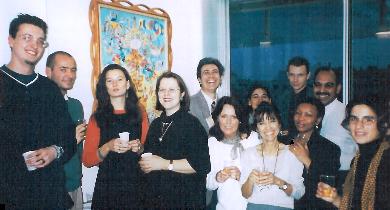Introduction and UNESCO's Mandate
Page 1
Yamousoukro and Seville Statement
Page 2
Origins and Executive Board Adoption
Pages 3 - 4
Launching the Programme: El Salvador and Roundtable
Pages 5 - 6 - 7
1993 General Conference
Page 8
National Projects
Pages 9 - 10
Programme Unit
Page 11
Toward a Global Scope
Pages 12 - 13
Transdisciplinary Project and Human Right to Peace
Pages 14 - 15 - 16
1997: A New Approach
Page 17
UN General Assembly Resolutions
Page 18
Resolution for International Year
Page 19
Declaration and Programme of Action
Pages 20 - 21
Resolution for International Decade
Pages 22 - 23
Training Programmes
Page 24
Global Movement
Pages 25 - 26
Publicity Campaign
Pages 27 - 28
Decentralized Network
Pages 29 - 30
Manifesto 2000
Page 31
Use of Internet
Pages 32 - 33
Future of the Culture of Peace
Pages 34 - 35 - 36 - 37 - 38
Director-General Mayor, himself, took a personal role at the center of the massive publicity campaign for the International Year. Following the strategy developed by SA/LAC, he signed thousands of letters to partners in the global movement. They began with his letter of July 1998 to all heads of national parliaments and his memo of 20 July to all UNESCO field offices, followed by letters in September to all National Commissions for UNESCO, on 22 October to all Nobel Peace Laureates and culminating in letters in 1999 to all Heads of State, Secretary-Generals of National Commissions for UNESCO, 1,000 mayors, thousands of University Presidents, UNESCO sectors and field offices and media professionals. Mention should also be made of his personal involvement in the preparation of a kit on the culture of peace, as well as a letter to participants in the World Conference on Higher Education held at UNESCO on 8 October 1998. In hundreds of personal meetings with Heads of State and International Organizations, both Intergovernmental and Non-governmental, he spoke of the culture of peace and the International Year. As a result, the culture of peace was featured in dozens of international declarations as listed in Appendix 2 of General Assembly Document A/53/370.
A key advance came on July 21-23, 1998 when the Director-General appointed Enzo Fazzino to work with me as coordinator of public awareness strategy and approved a substantial media budget for the International Year for the Culture of Peace. Since 1993, Enzo, with his wife Antonella Verdiani, had been developing the Planet Society Project, an approach to the global movement through a project of information exchange by grass-roots organizations working for sustainable development. This was a follow-up to the mobilization of the civil society at the 1992 UN Rio Conference. The experience and methods developed in the Planet Society, as well as key members of its team (Liselotte Andersen and Micheline Boulos, in addition to Enzo), provided us a core methodology and staff for the mobilization for the International Year for the Culture of Peace.

Enzo set about quickly to produce a public awareness strategy. He set up consultations with an ad-hoc working group, with Patricio Tupper of UNESCO and with Philippe Gilleron, an outside expert, and he presented the strategy to the Director-General, via Ms Prera Flores, the advisor for the Transdisciplinary Project, on 7 October 1998. As proposed, a relationship was then established with the firm EURO-RSCG of the Havas public relations group, headed by Mr Jacques Seguela. A series of breakfast meetings were held by Director-General Mayor and Mr Seguela with leading print, radio and TV media. Although the full potential of these meetings was never completely fulfilled, they did lead to the production of television and radio spots and print media inserts that reached an audience of millions during the International Year for the Culture of Peace. Particularly effective was the 45-second television spot featuring images of the leading Nobel Peace Laureates publicizing the Manifesto 2000, which was shown throughout the world in various languages. In France alone, the media campaign provided without cost to UNESCO was evaluated, in terms of equivalent advertising space, as six million French francs. Among the projects that did not come to fruition was a major television event planned by France Television for the launch of the Year; this collapsed when there was a change in management at France Television. A culture of peace cinema award, originally planned for the Cannes Film Festival in 2000, was eventually reduced to a UNESCO event with Radio France on 19 October 2000.
 |
 |
 |